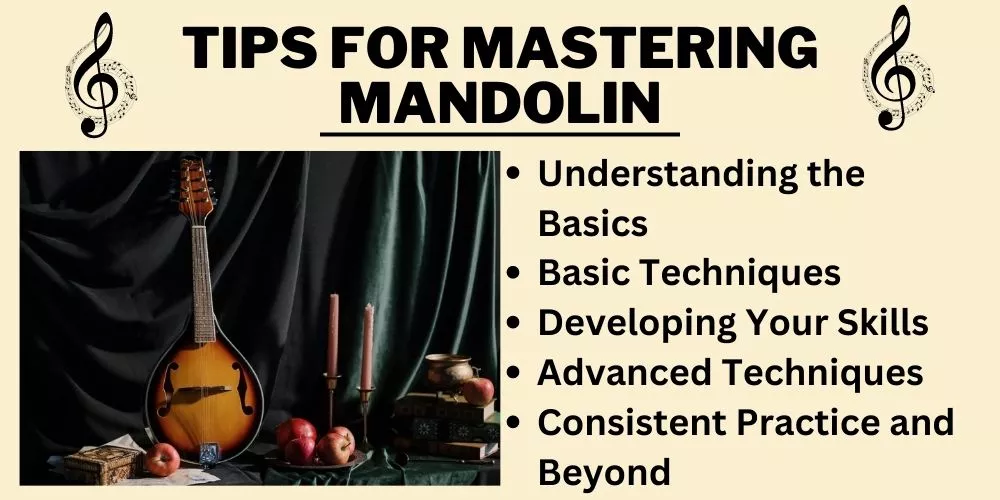Embarking on a musical journey often comes with a wave of questions and uncertainties, particularly concerning instrument selection.
Among the myriad of stringed instruments, one that quite often piques curiosity is the mandolin. But, is mandolin hard to learn?
Honestly, mastering mandolin isn’t a very easy task, and it has its own challenges like any other musical instruments. But, with right guidance and desire you can learn it pretty fast.
Mandolin has its distinctive lute-like body and melodious twang, the allure of this instrument is undeniable.

This article deeply examines the challenges and advantages novices may encounter while mastering the mandolin.
Whether you’re a seasoned musician looking to expand your repertoire or a music enthusiast standing at the threshold of their first instrumental encounter, we aim to provide a comprehensive guide to understanding what learning the mandolin entails.
Contents
🎶Is mandolin hard to learn?
Learning any musical instrument can be challenging, and the mandolin is no exception. However, like any skill, patience, dedication, and the right guidance can be mastered over time.
Here are some factors that contribute to the level of difficulty associated with learning the mandolin:

Familiarity with Other Instruments
If you are proficient in playing a different stringed instrument, especially the violin or the guitar, you might find learning the mandolin relatively easier. The fingering and picking techniques are similar and can give you a head start.
Violin Versus Mandolin
The mandolin and violin have the same tuning (GDAE), so violin players transitioning to mandolin would have an easier time understanding the notes and scales.
Guitar Versus Mandolin
Guitar players might need some adjustment as the mandolin is tuned in fifths rather than fourths. However, the concept of fretted notes is the same, and techniques such as hammer-ons, pull-offs, and slides transition well from the guitar to the mandolin.
Physical Aspects
Size and Fretboard
The mandolin’s small size can be both a blessing and a curse – while its compact body makes it easy to handle, the crowded fretboard requires precise finger placement.
However, the double-course strings (pairs of strings close together) can be simultaneously struck with the pick, making the execution of notes or chords easier compared to the guitar.
String Tension
The strings of a mandolin tend to have higher tension, which could pose a challenge for beginner’s fingers. Over time, with practice, your fingers will naturally develop callouses and the ability to withstand this tension.
Practice and Patience
Learning the mandolin requires time, practice, and patience, like any other instrument. Understanding musical notation, mastering new techniques, and developing a sense of rhythm and timing do not happen overnight.
Availability of Learning Resources
Fortunately, a wealth of resources are available to assist in mandolin learning. From online tutorials and courses to dedicated mandolin instruction books, numerous tools can help guide your learning process.
Additionally, a good music instructor can significantly enhance your learning experience.
While the mandolin does carry its challenges, stating that it’s hard to learn might be an oversimplification.
Like every instrument, the mandolin brings its unique hurdles and accelerators. Learning the mandolin can be a rewarding and enriching musical pursuit with commitment, consistent practice, and the right learning materials and guidance.
🎶How much time does it take to learn the mandolin?
The time it takes to learn the mandolin can vary greatly depending on several factors, such as a person’s prior musical experience, the amount of practice invested, the speed at which the person learns, and the level of proficiency the learner hopes to achieve.

- Beginner Level: For an absolute beginner with no previous musical experience, getting a grasp of the basic mandolin skills – like simple chord shapes, strumming patterns, and playing easy songs – might take a few months of regular practice. This would typically involve practicing at least 20-30 minutes daily, several days a week.
- Intermediate Level: Reaching an intermediate level, where you can comfortably strum along to more complex songs, understand and use a broader range of chords and techniques, and maybe even start to dabble in some improvisation, could take 1 to 2 years of consistent, focused practice.
- Advanced Level: Becoming an advanced player capable of tackling complex music compositions, improvising fluidly, or even mastering mandolin-specific styles like Bluegrass usually requires at least several years of dedicated practice.
Everyone progresses at their own pace, and these are just general estimates. The key to advancement is consistent, mindful practice, passion, and patience.
It’s also crucial to add that getting a good music teacher or enrolling in a structured course can significantly speed up the learning process.
Can you teach yourself mandolin?
Yes, you can undoubtedly teach yourself to play the mandolin. Many successful mandolin players are self-taught.
The process of self-learning can be enjoyable and rewarding. However, it does require motivation, consistency, and the right resources to guide you through the learning process.

Effective Learning Resources
- Books: Many well-structured mandolin method books cover beginner to advanced level concepts. These books offer lessons on techniques, music theory, and exercises that help develop your skills.
- Online tutorials: Online platforms such as YouTube host tutorials ranging from basics to advanced techniques, offering step-by-step guidance on mandolin playing.
- Online courses: Several websites offer paid, structured online courses tailored to different skill levels. These courses can guide you through your learning journey systematically.
- Mandolin forums and communities: Engaging with the mandolin community online or in person can help you learn from other players’ experiences and insights. These platforms can also help you overcome potential challenges and offer valuable support.
Tips for Effective Self-Learning
- Set goals: Start by outlining and breaking your goals into smaller, achievable milestones. This will provide a clear path for your learning journey and help you stay motivated.
- Practice regularly: Practice consistently, even if it’s just for a short period each day. Regular practice keeps your muscle memory and skills sharp, promoting steady progress.
- Learn music theory: Understanding the fundamentals of music theory can help you decipher sheet music and comprehend chord structures, scales, and harmonies, elevating your playing skills.
- Record and review your progress: Periodically recording your playing sessions helps you identify areas that need improvement and track your progress over time.
- Expand your listening: Broaden your musical horizons by actively listening to various genres and styles of mandolin playing. This can inspire you and contribute to your development as a well-rounded musician.
Is it harder to learn mandolin or guitar?
Comparing the difficulty of learning mandolin and guitar is subjective, as it largely depends on an individual’s preferences, learning capabilities, and previous musical experience.
However, there are distinct aspects of both instruments that could be considered more or less challenging by different learners.
Mandolin
- Small size and crowded fretboard: Mandolin’s compact size could be advantageous or challenging. The small fretboard requires precise finger placement, which might take time to master.
- String tension: The mandolin has higher string tension, which could be challenging for a beginner’s fingers. Over time, though, callouses form, and the fingers get accustomed to the tension.
- Tuning: The mandolin’s tuning (GDAE) might be unfamiliar to guitar players, but it is shared with the violin, which could make it easier for violinists to transition.
Guitar
- Larger fretboard: The guitar’s larger fretboard can be both a challenge and a luxury. While it requires wider finger stretches, it could be more forgiving regarding finger placement.
- More strings: The guitar typically has six strings, compared to the mandolin’s four pairs of strings. This might increase the complexity of chord shapes and fingerings.
- Tuning: The guitar uses a tuning system (EADGBE) based on intervals of fourths, which can be easier to learn chords and scales.
The difficulty in learning the mandolin or guitar ultimately hinges on individual factors, such as the learner’s innate skill, familiarity with similar instruments, and personal commitment to practice.
Both instruments present unique challenges but are equally rewarding to learn and have vast musical versatility.
As a learner, choosing the instrument that resonates with you the most and aligns with your musical interests is essential, as passion and motivation play a crucial role in overcoming any perceived difficulties.
What should I learn first on the mandolin?
When starting your journey as a mandolin player, it’s crucial to understand and practice a few fundamental aspects of the instrument. Here’s a list of essentials that you should focus on learning first:
- Mandolin Anatomy: Before you even start playing, you need to familiarize yourself with the various parts of the mandolin – such as the body, neck, fretboard, bridge, strings, and tuning pegs – and understand their functions.
- Holding the Mandolin: It’s essential to learn the correct way to hold the mandolin. This can significantly impact your comfort level while playing and your ability to reach the strings and frets.
- Basic Tuning: The mandolin has a unique tuning style – GDAE- the same as a violin. Learning to tune your mandolin correctly is an essential skill to develop early on.
- Finger Positions: You must familiarize yourself with the fretboard and learn proper finger placement techniques to produce clean notes and chords. Remember, the mandolin fretboard is quite narrow, so precision is essential.
- Basic Strumming Techniques: While mandolin players often utilize pick-based techniques similar to the guitar, this instrument requires a more distinct picking style, given the double strings. You must learn to hold the pick correctly and practice basic up and down strumming patterns.
- Basic Chords: Start with simple two-finger and three-finger chords. Once you’re comfortable with these, you can move on to full four-finger chords. It’s important to practice transitioning smoothly between the chords as well.
- Playing Simple Songs: Learn simple songs once you have a handle on basic chords and strumming. Playing recognizable tunes can boost morale and prove how much you’ve progressed.
- Reading Tablature: Tablature is an easier way for beginners to start reading music. It shows where each note is played on the fretboard. Numerous mandolin songs are available in tablature format, especially online.
Once you’ve mastered these basics, you’ll have a solid foundation to expand your mandolin skills. Remember, learning an instrument is a journey that requires patience, consistent practice, and enjoyment of the process.
Tips for Mastering Mandolin
Learning the mandolin can be a fun and rewarding venture. This guide provides an extensive step-by-step process.

Understanding the Basics
- Know Your Instrument: The first step in mastering the mandolin involves learning about the instrument itself. Understand the different parts of the mandolin, such as the fretboard, the body, the neck, the bridge, and the strings.
- Hold it Right: Learn to hold your mandolin correctly. The comfort of your position will significantly impact your ability to learn and play the mandolin effectively.
- Tuning: A mandolin is tuned in a specific way – GDAE. This tuning system is crucial to how the mandolin sounds and plays. Spend time learning how to tune your mandolin properly.
Basic Techniques
- Fingering Techniques: Now, focus on developing proper finger placement techniques. The narrower fretboard of the mandolin requires precision with your finger placements to produce the right notes.
- Strumming and Picking Techniques: Learn the correct way to hold the pick and basic strumming patterns. The mandolin requires a distinct picking style due to its double-string setup. Practice both down and up strokes.
Developing Your Skills
- Learn Basic Chords: Start learning and practicing the basic chords on the mandolin. Start with simpler two and three-finger chords and slowly move on to more complex four-finger chords.
- Chord Transitions: Once you can play some basic chords, start working on transitioning smoothly between these chords.
- Playing Simple Songs: Begin practicing with straightforward songs. This practice will help to develop your strumming, chord transitions, and overall playing skills.
- Reading Tablature: Tablature is a type of musical notation specific to fretted instruments. It shows you where to place your fingers on the fretboard rather than requiring you to understand musical notation.
Advanced Techniques
- Advanced Chords and Scales: Once you are comfortable with the basic chords, move on to more advanced chords and scales. Mastering these will allow you to play a wider range of songs and styles.
- Improvisation and Soloing: Improvisation is an advanced skill but a significant part of mandolin playing, especially in genres like Bluegrass and Jazz.
Consistent Practice and Beyond

- Develop a Practice Routine: Consistent practice is key to mastering the mandolin. Set aside dedicated time for mandolin practice every day.
- Always Keep Learning: You’re never done learning! Even after mastering the basics, there are always new skills to learn, songs to play, and techniques to conquer. Continue experimenting with different music styles and techniques.
- Take Lessons: Consider taking lessons from a knowledgeable mandolin teacher. A good teacher can provide valuable feedback, help you avoid developing bad habits, and guide you through challenging techniques or concepts.
- Join a Mandolin Community: Joining a local or online mandolin community can accelerate your learning process. You can learn from more experienced players, share your knowledge, and get feedback on your playing.
Remember, mastering the mandolin is a journey that requires patience, diligent practice, and a love for making music. Enjoy the journey as much as the destination.
🎶Frequently Asked Questions (FAQs)
Answer: The mandolin can be challenging for beginners due to its small size and high string tension. However, consistent practice and patience make the learning process smoother over time. Also, people with previous string instrument experience might find it easier due to some overlapping skills.
Answer: The difficulty in learning either instrument is subjective and depends on an individual’s musical background, learning capabilities, and interests. Both instruments present unique challenges – the mandolin’s high string tension and crowded fretboard vs. the banjo’s distinctive picking style and open tuning.
Answer: While it’s not essential to read music to play the mandolin, knowing how to read sheet music or mandolin tablature can significantly expand your ability to learn new tunes and understand musical concepts. However, many players learn by ear or through online video lessons.
Answer: Generally, the ukulele is considered easier for beginners due to its softer nylon strings, fewer strings (four single strings compared to the mandolin’s four pairs of strings), and less complex fretboard. However, which instrument is “easier” could vary depending on the individual and their musical background.
Answer: A guitar player can transition to the mandolin thanks to cross-applicable skills like strumming, picking, and understanding musical structure. However, significant differences between the instruments require learning and practice, such as the mandolin’s unique tuning and smaller, more crowded fretboard.
Conclusion:
Learning the mandolin, like picking up any new instrument, presents its own challenges – from the high string tension to the compact, narrow fretboard. However, labeling the mandolin as ‘hard’ to learn may not paint the full picture.
The difficulty level of learning the mandolin greatly depends on individual factors, such as a person’s prior musical experience, the amount of practice time devoted, and even hand dexterity.
The initial perceived difficulty should not overshadow the intrinsic value of learning an instrument.
As with mastering any skill, patience, persistent practice, and a will to learn are paramount in overcoming the mandolin’s learning curve, making the process all the more rewarding.
With adequate resources and guidance and a genuine love for music, learning to play the mandolin can result in gratifying melodic outcomes.
So, while the mandolin may be challenging to some degree, it’s important to remember that the journey of learning an instrument is filled with progression, personal growth, and joy, making it a worthwhile pursuit.
